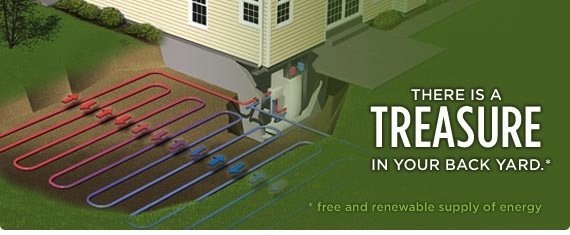Geothermal Heating and Cooling: A Short Overview
The use of geothermal energy for heating and cooling is catching on as a replacement for fossil fuels. It is efficient, economical, and it works anywhere in the country, no matter how hot or cold the outside temperature is.
Geothermal 101
Geothermal energy uses the limitless supply of energy located just below our feet. Below the frost line, the earth's temperature is a constant 50-55 degrees. Geothermal energy installations tap into this heat to reduce the home's overall heating and cooling loads. Instead of burning fuel for heat, geothermal simply moves heat: from the earth into the home, and vice versa.Traditional HVAC systems, even more energy-efficient models, use enormous amounts of energy to move heated or cooled air around the house. This can account for more than 50% of an average home's total energy usage. Geothermal is more efficient; the systems mild starting point creates a shortcut to the home's target temperature. Whether it's 100 degrees outside, or zero degrees, if you start out with 50 degrees, it's much easier to make the indoor temperature comfortable.
How Geothermal Works
During the cold winter months, the earth's heat is absorbed by a loop system of water-filled pipes that run under the ground. This heat is transferred to a geothermal unit in the home (which replaces both the furnace and the air conditioner). There, the heat is compressed to a warmer temperature using a refrigerant-type gas and circulated through the home via traditional ductwork.To cool the house, the system simply reverses. Warm air from the home goes into the geothermal unit, where it is transferred to the cooler earth via the loop system, and absorbed.
The results are the same as from any regular HVAC system: comfortable indoor air, year-round.
The main geothermal unit (taking the place of a furnace and air conditioner) works on the same principle of a refrigerator to remove heat from the earth to the home or from the house to the earth. Wired to a 50-amp circuit, the geothermal unit works without venting or combustion. No fossil fuels are burned, no greenhouse gases are created in-home, and the threat of carbon-monoxide poisoning is eliminated.
The Geothermal Setup
The underground piping can be installed in deep vertical coils, which uses less pipe and square footage, or horizontal coils in which loops of pipe fill shallower trenches just below the frost line.Installation Costs of Geothermal Systems
Installing a new geothermal system can be more expensive than traditional HVAC systems, but the gains in efficiency will cover the cost of the system over time. The typical ground-source geothermal system recoups its installation costs within 10 years; at that rate, it will pay for itself several times over during its lifespan.The Benefits of Geothermal Efficiency
Geothermal has many benefits for the green home, including:- Superior Efficiency: Standard HVAC systems are usually between 80% and 97% efficient: the average geothermal system is 400% efficient. For every four units of energy it delivers, one unit of energy is required to operate it.
- Lower Environmental Impact: Because there's no combustion of fossil-fuels, geothermal drastically reduces greenhouse gas emissions from the home.
- Safer: No combustion also means there's no hazardous fumes, eliminating the possibility of carbon monoxide poisoning.
- Long Lasting Durability: The underground loop system can last 50 years or more; the geothermal unit in the house will easily last 15 years or longer.
- Tax Credits/Rebates: Many areas offer federal tax credits or other local rebates to help lower the installation costs of a geothermal system.
As a case-study, an average-sized 2000-sq-ft. house in New York was retrofitted with a geothermal system. The house saw immediate savings with the combination of tax credits, increased efficiency, and a low-interest loan.
Installation cost: $30,000 -- $11,000 (tax credit) = $19,000
Annual costs: $3945 (old system) -- $2076 (geo) = $1869 saved
Payback period: $19,000 / $1869 = 10.17 years
Monthly fuel costs for old system: $329
Monthly geothermal costs: $173 (power) + $132 (loan) = $305
Geothermal energy is an elegantly simple way to efficiently heat or cool your home. Unlike wind and solar, geothermal power is constant, day and night. The earth's heat is always there, we just need to take advantage of it.
comments powered by Disqus



























































































































































































